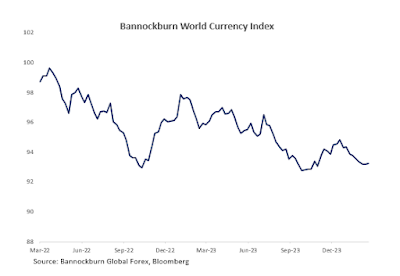Rarely are officials able to achieve the proverbial economic soft-landing when higher interest rates help cool price pressures without triggering a significant rise in unemployment or a contraction. Yet, without declaring victory, the Federal Reserve's confidence that this will be achieved has risen. Still, its increased confidence is unlikely to lead to a rate cut this month.
To appreciate where things stand begins with recognizing that what has characterized the first two months of the year is a reaction and correction to what happened in Q4 23.
The decline in interest rates in the last few months of 2023, in turn, helped lift the stock market. The S&P 500 rallied 11.25% in Q4 23, it best quarterly performance in three years. Much focus is on the narrow breadth of the market, as the Magnificent 7 (Apple, Amazon, Nvidia, Tesla, Microsoft, Meta, and Alphabet) which has replaced the FANG (Facebook, Amazon, Apple, Netflix, and Google) lead the way. Yet, the Russell 2000, which is an index of the shares of the 2000 smallest companies, gained 13.5% in Q4 23.
Falling interest rates knocked a leg out from the under the dollar. The greenback fell against all the major currencies in Q4 23. JP Morgan’s Emerging Market Currency Index had its best quarter of the year, rising 2.35% against the dollar in the last three months of 2023.
As is common in the capital markets, the pendulum of sentiment swings dramatically. Since the start of the year, the pendulum has swung back and this is true of Europe, Canada, and the United States. The market now recognizes the first cut will come later and the magnitude of rate cuts this year well be less aggressive than thought likely at the end of last year.
The first Fed rate cut has been pushed out of March and a rate cut is no longer fully discounted until July. The market has converged with the median in the Federal Reserve's December Summary of Economic Projections that anticipated three cuts would be appropriate this year. As recently as mid-January, the Fed funds futures market had 6 1/2 cuts discounted. The market has reduced the extent of ECB cuts to about 95 bp (from 160 bp at the end of January and 190 in late 2023). The Bank of England is now expected to cut rates twice and possibly three times this year (65 bp), which is about 105 bp less than was discounted at the end of last year. The extent of Bank of Canada rate cuts this year has been more than halved to around 75 bp from 160 bp in late December 2023. We suspect that the interest rate adjustment is nearly over.
Paradoxically, equities have continued to rally. The S&P 500 and NASDAQ have set new record highs, though the Russell 2000 is lagging. Lower interest rate expectations were previously cited by the bulls, and now the idea that economic activity may be stronger said to be inflaming the animal spirits. Japan's Nikkei has surpassed the 1989-1990 highs to reach new records. Europe's Stoxx 600 also set record-highs last month.
The US Q4 23 GDP grew by 3.2% at an annualized rate. Most economists had expected something closer to 2%. Moreover, the strong pace was achieved with moderating price pressures. The GDP deflator was halved to 1.6% (from 3.3%). Also, unit labor costs, which are a key competitive metric, combining labor compensation and productivity, fell in H2 23. To say the same thing, productivity gains more than offset the increase in wages/salaries and benefits.
A combination of stronger than expected US economic data and guidance by Federal Reserve officials encouraged the market to temper its aggressiveness. The economy appears a reasonably a strong start to the new year. In early February, the government reported that the economy grew over 350k jobs in January, which was nearly twice what economists expected. In the three months through January, US businesses created almost 750k jobs, the most in a three-month period since September-November 2022.
Not only were there more people working, but they were getting paid more. Average hourly earnings rose by 0.6% in January. That was twice as much as economists expected and the most in two years. The year-over-year rate stood at 4.5%. It continues to exceed the Consumer Price Index, which helps underpin demand.
The strength of the consumer is a key factor that helped avoid a recession that looked likely. Government deficit spending is arguably another crucial factor. The US budget deficit was around 6.5% of GDP last year. Some funds, such as within the Chips Act provisions, are slowly being distributed. More actual spending is in the pipeline.
The US deficit was twice the size of the Eurozone’s (3.3%), and larger than the UK’s (4.5%), Japan’s (5.2%), and Canada’s (1.2%) budget shortfalls. Projecting this year’s deficit requires making numerous assumptions, but many economists expect the deficit to be around 6% of GDP. That may still be twice as high as the Eurozone’s and higher than most others.
The Eurozone and UK are experiencing economic stagnation, and this looks likely to persist through most of the year. Inflation in both areas is likely to fall sharply in the coming months and this will allow the central banks to begin cutting interest rates. Japanese inflation is also falling, and the core rate slipped looks poised to below the 2% target. Despite the moderation in prices and an economy that looks weak at the start of 2024 after contracting in the past two quarters, we expect the Bank of Japan to raise its overnight interest rate from below zero (-0.10%) in April, though there is a risk could be at this month’s meeting (March 19).
China’s economy is underperforming Beijing’s expectations regardless of what the official data may show. There are promises of more supportive measures. At the same time, what China does appear to be doing well, like EV and battery production, solar panels, and processed rare earths, threatens its trading partners. An index of the 300 largest stocks on the Shanghai and Shenzhen exchange fell to five-year lows in early February before staging an impressive 13%+ rally, encouraged by formal and informal help from Beijing.
Weak economic impulses and the elevated geopolitical tensions make for a poor international backdrop. The risks are set to escalate. US aid to Ukraine may be in jeopardy, but Kyiv’s F-16, now with trained pilots, give it the capability to project deep into Russia. Meanwhile, a secondary consequence of Israel and the Hamas conflict is the loss of control of the Red Sea. Shipping costs have risen, especially between Europe and Asia. Oil prices have become more volatile, but net-net have risen by slightly more than 7% since the end of last year, while gyrating in about a $10-range below $80 a barrel. The average retail price of gasoline in the US is nearly 7% higher than at the end of last year, after falling nearly 20% in the last four months of 2024.
At first, Fed interest rate cuts may be explained not so much an easing policy as maintaining the same level of restraint as inflation falls. In effect, without a cut in the nominal interest rate, the real interest rate, would be too high to navigate a soft-landing. It is the real rate, economists argue, that is the key signal for businesses, investors, and policymakers. Later, as growth slips below 2%, the rate cuts will begin providing more monetary support to the economy. In Europe, labor markets have remained strong, giving officials more time for price pressures to moderate. The Swiss National Bank meets on March 21. With core inflation at 1.2% in January and growth weak, there is a reasonable risk that the SNB delivers the first rate cut among the high-income countries.
Lastly, we note three regularities during presidential election years. First, in the past 18 presidential cycles, going back to 1952, the economy has contracted twice (1980 and 2020). Second, the S&P 500 has fallen three times (1960, 2000, and 2008). Third, the Dollar Index (DXY), a basket of leading currencies, has mostly risen in the dozen presidential election years since the end of Bretton Woods. The record was perfect from 1976 through 2000. However, in the five elections since, the Dollar Index has falling in three times (2004, 2012, and 2020).
Most emerging market currencies fell against the dollar in February. The Mexican peso led with around a 0.9% gain, closely followed by the Peruvian sol. A few Asian currencies (Indonesian rupiah, South Korean won, Philippine peso, and Indian rupee) appreciated by about 0.15% to 0.40%. The Polish zloty was the only currency from central Europe to have gained (about 0.20%). The JP Morgan Emerging Market Currency Index fell by about 1.2% to bring the year's loss to slightly more than 3%. The MSCI Emerging Markets Currency Index rose by 0.20% after falling nearly 1% in January.
Rising by 4.6%, the MSCI Emerging Markets Index for equities, recouped what was lost in January. It outperformed the MSCI World Index of developed markets, which rose by about 4.1% in February. The premium emerging market bonds pay over US Treasuries, measured by the JP Morgan Emerging Bond Index narrowed slightly below 310 bp in February from 336 bp at the end of January. It is the tightest spread since May 2021.
Bannockburn's World Currency Index, a GDP-weighted basket of the currencies of the last dozen economies fell by about 0.65% in February. This reflected the weakness of all the foreign currencies but the Mexican peso, South Korean won, and Indian rupee, which together account for slightly more than 8% of the BWCI. All the G10 currencies in the index fell, led by the yen's 2% slump.
BWCI fell to a 20-day low in early Q4 23. It rebounded by about 2.25% in November and December 2023 and reached a four-month high at the end of the year. As the greenback recovered in January and February, BWCI fell by about 1.75%. It snapped a six-week slide by rising in the final week of the month. Now that market expectations have converged with Federal Reserve's projections from the end of last year, and official comments still seem to endorse those view, we suspect the key driver in recent weeks has largely run its course. Weak economic data may reinforce the cap on rates, sap the dollar's strength and allow the BWCI to recover.
U.S. Dollar: The market, as it did a few times last year, ran well ahead of the Federal Reserve, only to converge later. That adjustment now appears over. Official comments do not suggest a meaningful change in views since the December's Summary of Economic Projections, which anticipated 75 bp of cuts this year. The Fed's forecast will be updated at the March 20 meeting. There will also be an update on the unwinding of the balance sheet. It appears money market funds and others have born most of the adjustment with bank reserves little changed. Still, some tapering before stopping seems likely, perhaps beginning in Q2. Meanwhile, even though the January job growth was nearly twice the forecast, economic activity is slowing, and this may also help cap yields and the dollar in the weeks ahead. The Fed's facility launched last year (Bank Term Funding Program) will stop new loans (one-year) on March 11. The focus has shifted away from the systemically important banks and toward regional banks, where commercial real estate exposure is significant. The index of shares of large US banks is essentially is up a little less than 1% while the index of regional bank shares is off 10% this year. The Dollar Index rose from around 100.60 in late December to 105.00 in mid-February. The recovery appears over, and in the pullback, we anticipate in March, the Dollar Index could fall toward 102.00.
Euro: Economic activity in the region
has stagnated since late 2022, and while things do not appear to have gotten
worse, growth impulses seem faint at best. Unemployment, however, remains near
record lows despite the tightening of the monetary policy and the lack of
growth. This seems to embolden the European Central Bank to wait until
inflation falls further toward target before easing monetary policy. And prices
pressures are set to fall sharply in the coming months that will likely lead to a
sub-2% rate in the second quarter. The preliminary February rate stood at 2.6%,
down from 2.8% at the end of last year and 8.5% in February 2023. The ECB will
update its forecasts in March. In December, it had forecast this year's growth
at 0.8% and inflation at 2.7%. Both seem to be vulnerable to downward
revisions. The European Parliament elections in June will increasingly dominate
the officials’ bandwidth. Immigration challenges and farm prices have emerged
as key issues. The euro fell from about $1.1140 late last year to around $1.07
in mid-February. A recovery may have begun, perhaps there may be scope toward $1.0950-$1.1000 area, but suspect a new, higher trading range is more likely
than a sustained uptrend.
(As of March 1, indicative closing prices, previous in
parentheses)
Spot: $1.0835 ($1.0855) Median
Bloomberg One-month forecast: $1.0880 ($1.0875) One-month
forward: $1.0865 ($1.0850) One-month implied vol: 5.5% (6.2%)
Japanese Yen: Japan continues to have
a negative policy rate, debt-to-GDP of over 250% and central bank's balance
sheet more than 125% of GDP, an exchange rate that is extremely undervalued and
yet inflation core inflation, has fallen back to 2%. Moreover,
the economy contracted in Q3 23 and Q4 23, and is off to a weak start to 2024,
with a 7.5% decline in January's industrial output. Nevertheless, we still
the Bank of Japan is committed to lifting the target rate from -0.10%, which is
likely in April, after the results of the spring wage round (March 15) and as
the government subsidies for electricity and gas for households end, ahead
of the income tax cut. Bank of Japan Governor Ueda has emphasized the rise of
services prices, but we suspect that the negative rate is seen to hamper
monetary policy. He appears committed to lift rates barring some new shock.
Officials will try to convince businesses and investors that exiting negative
interest rates is not the beginning of tightening sequence. Monetary policy
settings are still very accommodative. The effective overnight rate has been
hovering near -0.05%, or about half as negative as the target. The BOJ owns almost 2/3 of
the equity ETFS, which account for around a quarter its assets. The Nikkei
rallied more than 28% in 2023 and is up about 19.25% here in 2024. Even for
unhedged, dollar-based investors, the return is half again as much as the
S&P has generated in the first two months of the year. The exchange rate
remains sensitive to US interest rates. If US 10-year yields continue to rise,
the JPY152 area, which capped the dollar in the last two years, will be
challenged again. Japanese official verbal intervention has injected a note of
caution into the market. One the one hand, the dollar rose in the first eight weeks of the year before the small (~0.25%) loss in the weekend ending March 1. This speaks to a one-way market. On the other hand, the two-year low in the
benchmark three-month volatility reflects an orderly market.
Spot: JPY150.10 (JPY148.15) Median
Bloomberg One-month forecast: JPY148.45 (JPY145.65) One-month
forward: JPY149.45 (JPY147.45) One-month implied vol: 7.7% (8.2%)
British Pound: The US jobs data and the CPI pushed sterling out of the $1.26-$1.28 trading range in February. The low was set after the employment report near $1.2520. However, sterling recovered and finished the month in the old range. The British economy contracted for the second consecutive quarter in Q4 24, meeting the Bank of England's definition of a recession. The market looked past it, and sterling settled higher on the day of the GDP report (February 15). Chancellor of the Exchequer Hunt delivers the Spring Budget on March 6. The prime minister and chancellor have been hinting at tax cuts ahead of what is expected to be an election later this year. The most impactful cuts would for the national health system or income taxes. Depending on the spending cuts that may also be announced, many look for GBP15-GBP20 bln of tax cuts. The personal allowance has been frozen since 2021, and un-freezing them may have a greater impact than a small tax cut. Also, there has been some suggestion that the fuel duty increase scheduled to start later in March could be scrapped, but the Tory's would receive less recognition for canceling a tax hike than a tax cut. Meanwhile, inflation is likely to fall sharply in the coming months as the large jump in February-May 2023 (11.4% an annualized pace) drops out, and even with conservative assumptions, the year-over-year pace is likely to fall below 2%. This may encourage the market to bring forward the first rate cut, which the overnight index swaps do not have fully discounted until August. Sterling, as we saw in Q4 23, need not be adversely impacted by the shift in expectations. With the downside break worth less than a cent, sterling could test the upper end of the old range, seen near $1.28. The high from late last year was almost $1.2830.
Spot: $1.2655 ($1.2705) Median Bloomberg One-month forecast: $1.2670 ($1.2655) One-month forward: $1.2660 ($1.2735) One-month implied vol: 5.8% (6.6%)
Canadian Dollar: Unlike Japan and the UK, Canada managed to avoid contracting for the second consecutive quarter in Q4 23. It grew by around 1.1% at an annualized, offsetting in full the revised 0.5% contraction (from -1.1% initially) in Q3 23. The economic impulses will likely remain subdued through mid-year but without the economy contracting, the central bank does not have much of a sense of urgency to cut rates. Still, like the eurozone and UK, Canadian inflation rose sharply early last year (6% annualized in the first five months of 2023), In the five months through January, Canada's CPI actually declined slightly (not risen slower). Even if that pace is not maintained, and CPI rises by an average of 0.2% a month from February through May, it may slip below 2%. The underlying rates softened in January after stagnating in Q4 23. The swaps market does not have the first cut fully discounted until July and it has a little more than three cuts fully discounted this year. At the end of January, the market had the first cut priced in for June and anticipated 100 bp in cuts in 2024. The Bank of Canada meets on March 6 and there is practically no chance of a rate cut. The Canadian dollar has fallen every week but one so far this year and the advancing week was about 0.02%. Two-thirds of this year's 2.1% depreciation of the Canadian dollar took place in January. The US dollar rose to its best level since mid-December in late February, slightly above CAD1.3600. A move above CAD1.3625 signals another leg up, but in lieu of that a consolidative phase is likely that can re-test the CAD1.3450 area seen in late January/early February. Benchmark three-month implied volatility is near 5%, a four-year low. It was flirting with 4% before the pandemic.
Spot: CAD1.3560 (CAD 1.3455) Median Bloomberg One-month forecast: CAD1.3515 (CAD1.3475) One-month forward: CAD1.3555 (CAD1.3445) One-month implied vol: 4.9% (5.0%)
Australian Dollar: The Australian dollar recorded the low of the year so far with the US January CPI on February 13 slightly below $0.6450. This seems to have completed the pullback after the six-cent rally in the last two months of 2023. Provided the $0.6490 area holds, there may be scope back to $0.6600-$0.6625. Since the start of the year, changes in the exchange rate have been highly correlated with changes in gold (near 0.80, the upper end of where the correlations over the past five years. Reserve Bank Governor Bullock did not rule out higher rates, but the derivative's market clearly expects the next move to be a cut. The market is nearly a 75% chance of a cut in June, while a quarter-point move is not fully discounted until September. At the end of January, the market had nearly a 70% chance of a May cut and a 95% chance of a June cut. Still the slight tick-up in the January monthly CPI to 3.6% from 3.4%, the two-year low print in December will reinforce the cautious approach by the RBA when it meets on March 19. February's employment report is due the next day. Growth will likely remain subdued in 0.2%-0.3% a quarter here in H1 24.
Spot: $0.6530 ($0.6575) Median Bloomberg One-month forecast: $0.6575 ($0.6635) One-month forward: $0.6535 ($0.6585) One-month implied vol: 7.9% (9.0%)
Mexican Peso: The Mexican economy eked out a 0.1%
expansion in Q4 23. Based only a small set of high-frequency data points for
the new year, it looks economic activity has increased a little. Inflation is
continuing to moderate. The central bank appears to have adopted what could be
considered an easing bias. Still, with the market pushing out expectations for
the first Fed cut, Banxico may not sense a great urgency to cut. However, there
is another consideration. If it does not cut on March 21, the next opportunity
would be May 9. The national election is June 2. This may be too close to shift policy for comfort. The short-dated cetes
(T-bills) already seem to be anticipating a cut. The dollar traded between
approximately MXN16.9950 to MXN17.2855. It is the narrowest monthly range in
almost a decade. This is also reflected in the options market, where implied
volatility has fallen to four-year lows, below 9%. The peso was the strongest currency in February, gaining about 0.9% against the US
dollar. In region, the Peruvian sol was second with
about a 0.35% gain and the Brazilian real was virtually flat. Still, we remain
concerned that market positioning leaves it vulnerable to a sell-off ahead of
the election.
Spot: MXN17.02 (MXN17.16) Median Bloomberg One-Month forecast: MXN17.12 (MXN17.33) One-month forward: MXN17.11 (MXN17.25) One-month implied vol: 7.4% (10.3%)
Chinese Yuan: Officials succeeded in maintaining a steady yuan (against the dollar) and stopping the six-month rout of the CSI 300. Beijing did not push hard to strengthen the currency but did manage to keep it in a narrow range (approximately CNH7.1765-CNY-7.1995). That is the narrowest monthly range since July 2015. Although the reference rate that the People's Bank of China sets daily allows the dollar to trade a little above CNY7.24, the CNY7.20 has proved a formidable cap. We suspect it is tactical and not strategic on the part of officials. That means that if the dollar continues to appreciate against the other major currencies, especially the Japanese yen, the risk is that the dollar breaks higher against the yuan too. It is difficult to know the intent of officials, but above CNY7.20 could signal a return to the previous range (roughly CNY7.25-CNY7.30). Reports that China's sovereign wealth funds and large asset managers were buying equities encouraged others to do so as well. The CSI 300 rose 7% in the holiday-shortened month, the biggest rally since January 2023, and offset the January decline in full. Starting March 5, two important conferences begin. They are the country's legislature, a 3000-person strong National People's Congress and an advisory group, Chinese People's Political and Consultative Conference. This year's growth target (5%?) is expected to be announced. There will be personnel changes, and new economic pronouncement. We think more stimulus and "reforms" will be forthcoming. At the same time, economic tensions with the US and Europe are high and Chinese forces have continued to be aggressive toward Taiwan, the Philippines, Japan's the Senkaku Islands/Diaoyutai Qundao (disputed by both China and Taiwan), as well as Nepal and Bhutan.
Spot: CNY7.1970 (CNY7.1775) Median Bloomberg One-month forecast: CNY7.1815 (CNY7.1640) One-month forward: CNY7.1070 (CNY7.0950) One-month implied vol 4.8% (4.7%)
Tags: Featured,macro,newsletter




























